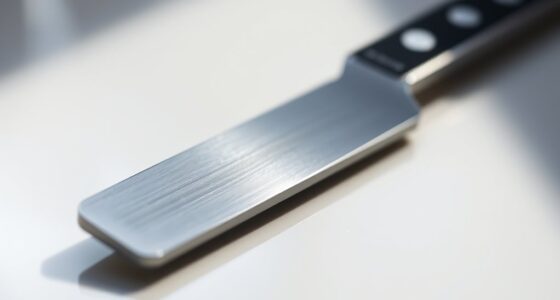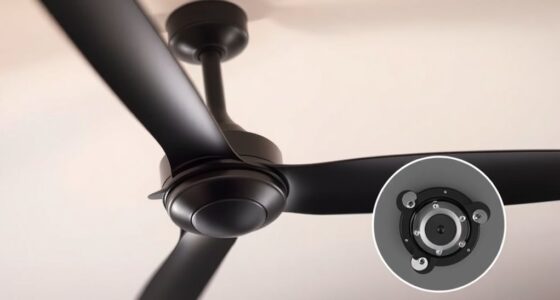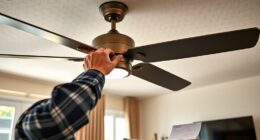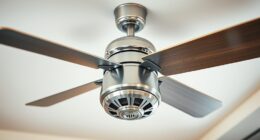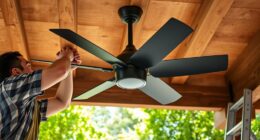Using your ceiling fan with your AC can boost cooling efficiency, lower energy bills, and improve indoor air quality. Fans help circulate air evenly, creating a wind-chill effect that makes the room feel cooler without extra energy use. Properly timed and maintained fans reduce strain on your AC and help control humidity and pollutants. If you want to maximize comfort and savings, there’s more to discover about ideal fan use and placement.
Key Takeaways
- Ceiling fans improve AC efficiency by promoting even airflow and reducing stagnant spots, lowering energy use.
- Using fans with AC helps control humidity and indoor air quality by circulating moist air and dispersing pollutants.
- Proper fan placement and rotation (counterclockwise in summer, clockwise in winter) maximize cooling and heating benefits.
- Fans create a wind-chill effect, allowing higher thermostat settings and reducing overall cooling costs.
- Regular maintenance and correct operation prevent wobbling, noise, and ensure optimal energy-efficient airflow.
How Ceiling Fans Enhance AC Efficiency

Ceiling fans can markedly improve your air conditioning system’s efficiency by helping to distribute cooled air more effectively. Regular ceiling fan maintenance ensures that fan blade materials stay in good condition, preventing wobbling or noise that can reduce airflow. Different fan blade materials, like wood, plastic, or metal, impact durability and performance, so choosing the right type is key. Dirty or damaged blades diminish circulation, forcing your AC to work harder. Cleaning blades periodically and inspecting for damage keeps the fan running smoothly. When your ceiling fan functions properly, it helps spread cooled air evenly across the room, reducing the workload on your AC. Proper fan operation also contributes to better airflow, which enhances energy efficiency, saving you money on cooling costs.
Energy Savings When Using Fans and Air Conditioning Together
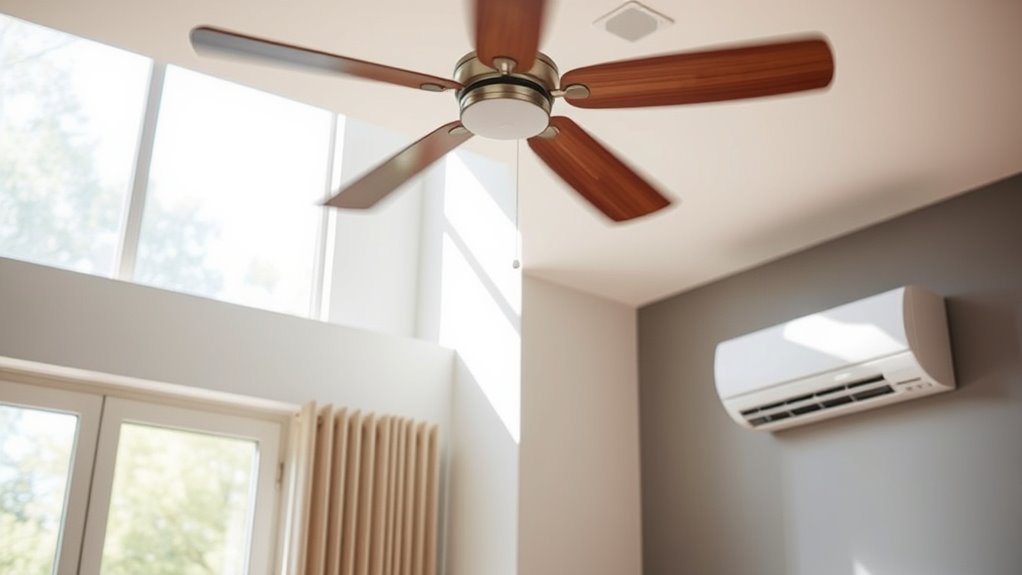
Using fans together with your air conditioning can help cut your cooling costs and improve comfort. When fans circulate air, your AC doesn’t have to work as hard to maintain a consistent temperature. This combination lowers energy consumption while keeping your home cooler and more comfortable.
Reduced Cooling Costs
When fans and air conditioning work together, you can substantially cut your cooling costs. Using a smart thermostat helps optimize your AC’s operation, adjusting temperatures based on when you’re home or away. This reduces unnecessary cooling and saves energy. Additionally, insulation upgrades keep conditioned air inside, making your AC work less to maintain comfort. Ceiling fans assist by circulating air and creating a wind-chill effect, allowing you to set your thermostat higher without sacrificing comfort. Incorporating natural materials and vintage decor can also enhance airflow and overall efficiency. Combining these strategies means your AC runs less often and less intensively, which lowers your energy bills. In short, integrating ceiling fans with smart thermostats and insulation improvements can markedly reduce your cooling expenses while maintaining a comfortable home environment.
Enhanced Temperature Regulation
Pairing ceiling fans with your air conditioning system enhances your ability to regulate indoor temperatures more precisely. This synergy improves humidity control and airflow patterns, making your space more comfortable. To maximize benefits:
- Adjust fan speed to create consistent airflow, reducing hot or cold spots.
- Use fans to circulate air evenly, complementing your AC’s cooling efforts.
- Set fans to run counterclockwise in summer for a cooling breeze.
- Rely on fans to help maintain stable temperatures, allowing your AC to operate more efficiently.
- Incorporate energy-efficient ceiling fans to further reduce your overall cooling costs and improve your home’s ventilation.
Lower Energy Consumption
Did you know that combining ceiling fans with your air conditioning can substantially cut your energy bills? When used together, fans help distribute cool air more efficiently, allowing you to set your AC thermostat higher without sacrificing comfort. Regular ceiling fan maintenance guarantees ideal performance and energy savings, preventing wobbling or noise that can decrease efficiency. Additionally, fan blade design plays a key role; blades shaped to maximize airflow reduce the workload on your AC. By enhancing fan placement and maintaining proper blade angles, you can lower your cooling costs considerably. Using glycolic acid products can also improve your skin’s overall appearance, making the environment feel fresher and more comfortable. This synergy between fans and AC not only conserves energy but also extends the lifespan of your cooling system, making your home more eco-friendly and budget-friendly.
The Ideal Fan Settings for Maximum Comfort and Savings
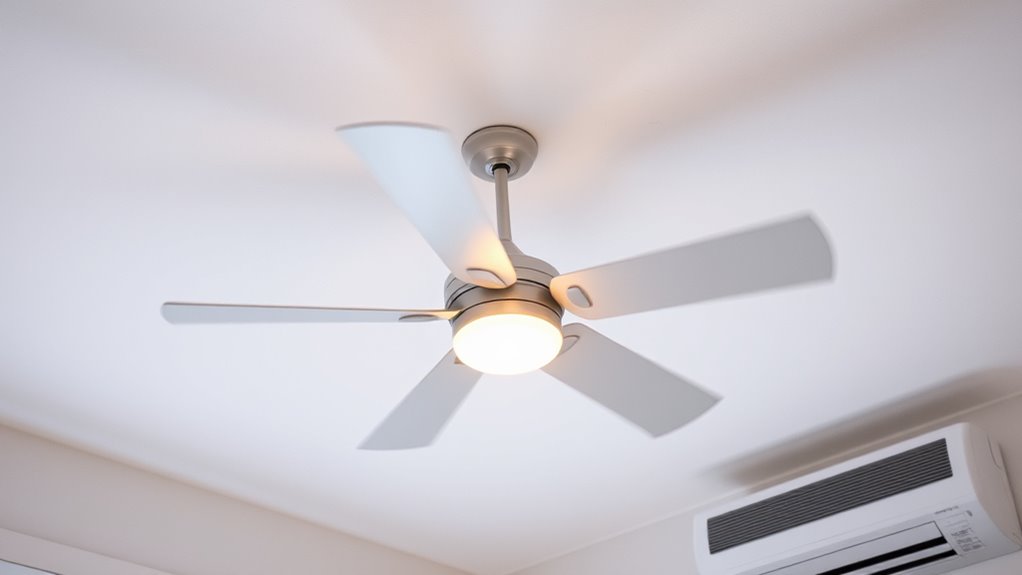
To achieve maximum comfort and energy savings, setting your ceiling fan to the right speed and direction is essential. Adjusting fan blade angles can optimize airflow, while selecting the correct fan speed settings guarantees efficiency. Here are key tips:
Optimizing fan speed, direction, and blade angles enhances comfort and energy efficiency year-round.
- Use low fan speed in cooler months to circulate warm air without creating a draft.
- Set the fan to a clockwise rotation during winter to push warm air downward.
- In summer, switch to a counterclockwise direction for a cooling breeze.
- Keep fan blade angles optimized for maximum airflow without excess energy use.
Common Myths About Running Fans With Your AC
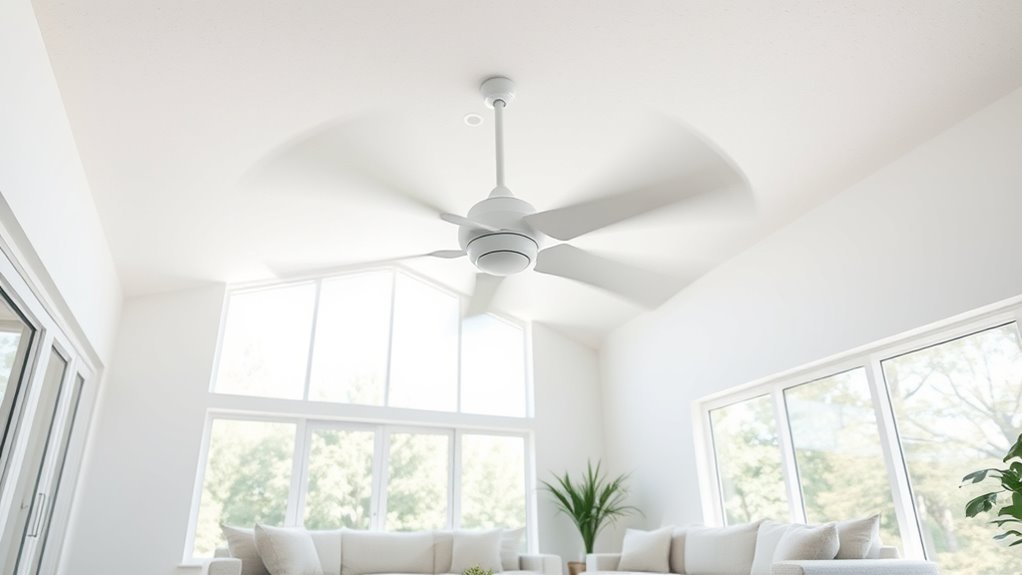
Many people believe that running fans alongside their AC will substantially increase energy bills, but this isn’t always true. Myth busting reveals that ceiling fans and ventilation fans can actually improve comfort without considerably raising costs. A common fan misconception is that fans cool the air directly, but they mainly create a wind-chill effect that makes you feel cooler. This means you can set your thermostat a few degrees higher while fans provide comfort, saving energy. Some think fans interfere with AC efficiency, but when used correctly, they work together to circulate air and maintain even temperatures. Additionally, understanding air circulation principles helps optimize your cooling system, reducing unnecessary energy use and enhancing comfort without extra expense.
Environmental Benefits of Coordinated Cooling
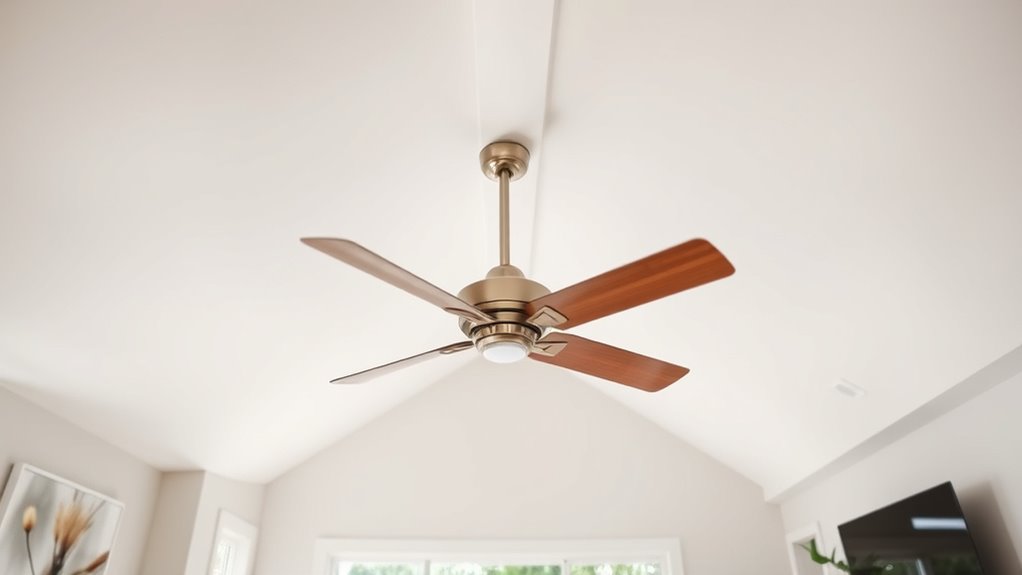
Using ceiling fans with your AC can cut down your energy use and lower utility bills. This coordinated cooling also helps circulate indoor air better, improving overall air quality. By making your cooling system more efficient, you’re doing your part to reduce your environmental impact. Additionally, incorporating high-efficiency projectors for home entertainment can further enhance energy savings by reducing the need for multiple electronic devices.
Energy Consumption Reduction
Coordinating the operation of ceiling fans with air conditioning can considerably cut down on energy consumption. By optimizing fan settings, you reduce the workload on your AC, lowering energy bills and environmental impact. Modern ceiling fan design and advanced fan motor technology make this even more effective. Here are four ways you benefit:
- Decrease AC usage by up to 40%, saving energy and money.
- Enhance cooling efficiency with well-designed fan blades that maximize airflow.
- Use quiet, energy-efficient fan motors for long-term savings.
- Reduce overall carbon footprint by lowering electricity demand.
With better-designed ceiling fans and smarter motor tech, your cooling system becomes more eco-friendly. This coordinated approach helps you stay comfortable while making a positive environmental impact. Incorporating energy-efficient materials in fan construction further amplifies these benefits over time.
Improved Indoor Air Quality
When you operate your ceiling fan alongside your air conditioning, you can considerably improve indoor air quality by promoting better air circulation and reducing indoor pollutants. The increased airflow helps with air filtration, preventing the buildup of dust, allergens,, and airborne particles. Additionally, the ceiling fan aids in humidity control by circulating moist air, which can lower indoor humidity levels and inhibit mold growth. This coordination reduces the chances of musty odors and respiratory issues caused by excess moisture. Enhanced air circulation also disperses indoor pollutants more effectively, creating a healthier environment. Vetted – 1st Home Theatre Projector By combining your ceiling fan with your AC, you not only boost comfort but also foster cleaner, fresher indoor air, leading to a more pleasant and healthier living space.
Tips for Proper Ceiling Fan Placement and Operation
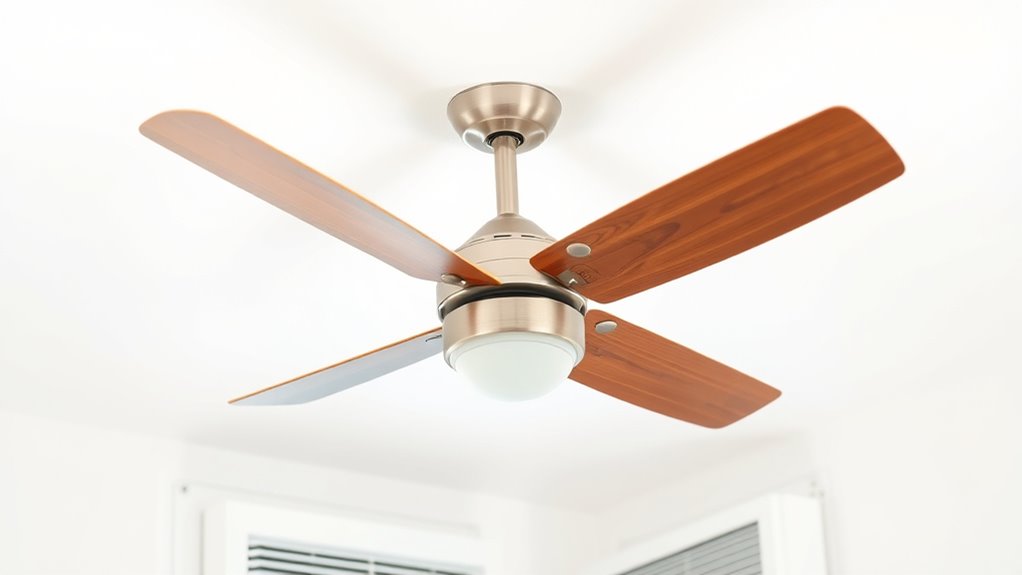
Proper ceiling fan placement is essential for maximizing comfort and efficiency. To get the most out of your fan, keep these fan operation tips in mind:
- Install the fan at least 7-9 feet above the floor for ideal airflow.
- Position the fan blades to rotate clockwise in winter and counterclockwise in summer.
- Avoid placing the fan directly over furniture or obstacles that block airflow.
- Ensure the fan is centered in the room for even circulation.
- Regularly check for signs of spoilage in the fan’s motor or blades to maintain safe operation.
How Ceiling Fans Improve Air Circulation and Indoor Air Quality
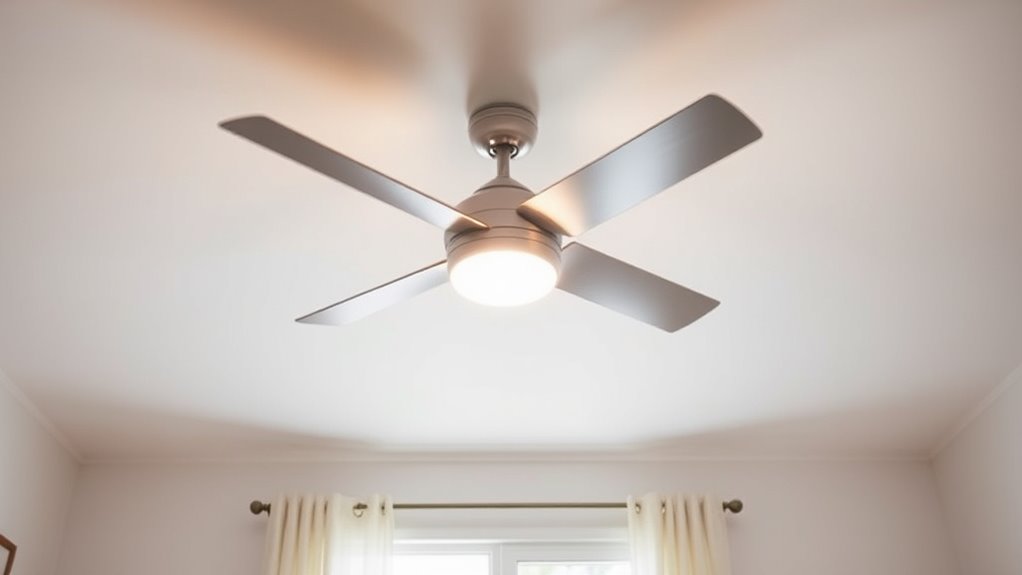
Ceiling fans play a vital role in enhancing air circulation within your home, which directly impacts indoor air quality. By moving air efficiently, fans help prevent stagnant spots, reducing dust, allergens, and odors. Better air circulation ensures fresh air reaches all corners, making your indoor air healthier and more comfortable. To illustrate, consider this:
| Effect | Result | Benefit |
|---|---|---|
| Improved air flow | Reduces indoor pollutants | Cleaner, healthier environment |
| Even temperature | Decreases hot and cold spots | Increased comfort |
| Moisture control | Prevents mold and mildew buildup | Better air quality overall |
With proper ceiling fan use, you actively improve indoor air quality, creating a fresher, more breathable space. Additionally, incorporating ceiling fans with rustic farmhouse style can enhance both aesthetics and airflow in your decor.
Cost-Effective Ways to Optimize Your Cooling System
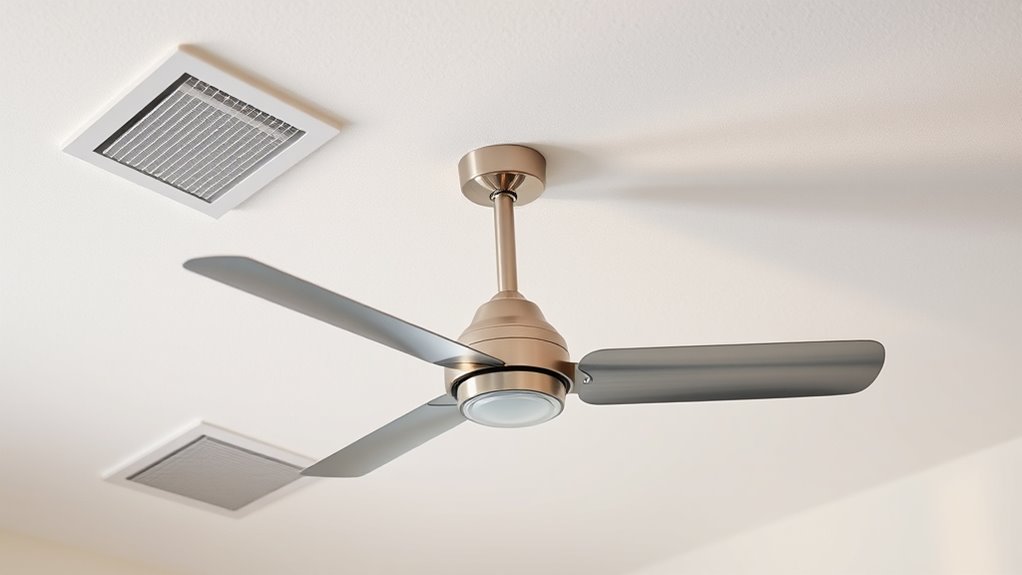
To save money on cooling costs, start by using your existing system more efficiently. First, schedule regular ceiling fan maintenance to guarantee ideal airflow and energy efficiency. Second, upgrade your ventilation system—adding attic vents or exhaust fans can reduce your AC’s workload. Third, use ceiling fans to supplement your AC; they circulate air and allow you to raise the thermostat setting without sacrificing comfort. Fourth, seal leaks around windows and doors to prevent cool air from escaping. Fifth, consider the best automatic hair curlers for quick styling, which can help you look great without adding extra heat from styling tools. Combining these strategies helps your AC work less while maintaining a comfortable environment. These simple, cost-effective steps maximize your cooling system’s performance and reduce energy bills without major investments.
Troubleshooting Common Issues When Combining Fans and AC

When combining fans and AC, you might encounter issues that hinder your cooling efficiency. One common problem is fan blade maintenance; dust and dirt buildup can cause wobbling or noisy operation, reducing effectiveness. Regularly cleaning and balancing your fan blades guarantees smooth, efficient airflow. Remote control issues are another frequent obstacle—if your fan or AC isn’t responding, check the batteries or reset the devices. Sometimes, remote signals get disrupted by obstacles or interference, so ensure a clear line of sight. Additionally, verify that your fan’s speed settings and the AC’s temperature controls are correctly synchronized. fan blade maintenance is crucial for optimal performance. Addressing these issues promptly helps maintain ideal cooling performance and energy efficiency, preventing minor problems from escalating into bigger, costly repairs.
Frequently Asked Questions
Can Ceiling Fans Be Used Effectively in Winter Alongside AC?
Yes, you can use ceiling fans effectively in winter alongside your AC. Simply reverse the fan’s direction to clockwise at a low speed, which pushes warm air down and improves energy conservation. This helps maintain indoor air quality by evenly distributing heat. Using fans this way reduces your heating costs and keeps the room comfortable, making your home more efficient without sacrificing comfort.
How Do Ceiling Fan Blade Angles Affect Cooling Efficiency?
You’ll find that blade pitch directly impacts your ceiling fan’s airflow efficiency. A steeper blade pitch increases airflow, helping you feel cooler faster. If the pitch is too shallow, the fan won’t move enough air, reducing cooling effectiveness. Adjusting the blade angle ensures maximum airflow efficiency, so you get better cooling with less energy. Keep in mind, the right blade pitch makes your fan work smarter, not harder.
Are There Specific Ceiling Fan Features That Optimize AC Performance?
Think your ceiling fan’s just a pretty ornament? Think again. Look for models with energy-saving modes and smart control features—they optimize your AC performance by adjusting speed and airflow intelligently. These features reduce energy waste, keep your room comfortable, and save you money. So, don’t settle for basic fans; upgrade to smart, energy-efficient ones, and let your fan do the heavy lifting while you relax.
What Safety Precautions Should Be Taken When Running Fans and AC Together?
When running fans and AC together, you should guarantee proper electrical wiring to prevent overloads or shorts. Keep fan placement away from vents or airflow paths that might disrupt cooling efficiency and cause safety issues. Always turn off the power before installing or adjusting wiring, and follow manufacturer instructions. Regularly inspect wiring and fan placement to avoid electrical hazards, ensuring safe and ideal operation of both appliances.
How Does Room Size Influence Fan and AC Combination Strategies?
Think of your room size like a tennis court—larger spaces need more support. For big rooms, choose a fan with higher capacity to circulate air effectively and verify your AC isn’t overworking. In smaller rooms, a smaller fan boosts comfort without wasting energy. Properly matching fan capacity to room size helps optimize cooling, saving energy and maintaining a comfortable environment, no matter how big or small your space is.
Conclusion
Using ceiling fans with your AC can cut energy costs by up to 40%, making your home cooler and more efficient. When you optimize fan settings and placement, you not only save money but also improve air circulation and indoor air quality. Remember, running fans doesn’t increase your cooling bill—it’s a smart way to enhance comfort and efficiency. Embrace these tips, and you’ll enjoy a more sustainable, cost-effective way to stay cool all season long.


